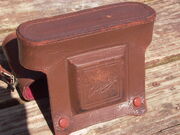The Please Six is a Japanese 6×6cm folding camera, about which little is known.

Please Six Front eastwestphoto-

Please Six Top View Eastwestphoto--

Rare Please Six Leather case Eastwestphoto--

Please Six Top off & lens. Eastwestphoto
Description[]
The Please Six is a horizontal folder, with three-part folding struts inspired by the 6×6 Ikonta. It is said to have an unusually large size.[1] There is a direct vision finder in the middle of the top housing, and a brilliant finder on the left, as seen by the photographer. The round window of the brilliant finder is easily mistaken for a rangefinder second image window when seen from the front, and this was certainly the effect sought by the designers of the camera. There is an accessory shoe between the two finders, and the folding bed release is placed in front of it.
The advance knob is at the right end of the top housing; it has an arrow engraved to indicate the turning direction and has a round leather patch at the top. The shutter release is at the usual location next to it. There is a sliding lever at the front of the top housing, under the advance knob, certainly meant to look like the unlock lever of an auto-stop advance mechanism. This lever actually removes an orange mask which appears in the viewfinder when the shutter release is pressed;[2] the practical utility of this device is of course very low.
The back is removed together with the bottom plate for film loading; they are locked into place by a rotating knob under the camera in the middle. There is a single red window in the middle of the back, protected by a horizontally sliding cover. The pressure plate is removable and curiously has a large squarish hole with round edges in the middle; this might be reminiscent of the Mamiya Six.
Eastwestphoto Rare Model----- Please SIx ---- No serial # on Body, Lens is a Seriter 7.5cm F:3.5 #2793 with a stranger early NKS shutter with OLD metric F:stops F:3.5, 4.5, 6.3, 9,12.5,18,25---- This is extremly odd for a japanese folding Camera of post war era & is really Pre war in design. So let's discuss this Oxymoron camera--- A coated early post war lens married to a pre war NKS shutter B,1~200 with self Timer and a very early flash post design(Post war?) . I suspect that this was a prototype Camera as Now there are only THREE susrving examples on planet earth! The struts are Cheap beyond belief and made by Fuji Kogaku Seisakusho Koki. NOT the maker of Fuji Film Co. products. The bellows are cheap thin garbarge! The build quality is so poor when you take the top off that I would compare it too a Pressed tin HIT type camera. Everything except the lens is cheap. A protype that didn't make it as it was a hacked together of parts from many other manufacturer's extra parts or old stock. The Mamiya like pressure plate, the reverse threaded winding knob, the triple spring loaded double exposure warning system, seems to indicate to me; a seasoned vet of Japanese early folding cameras of 1936~1950 a extreme SHORTAGE of parts, an attempt to get a prototype to market & a failure of the design! The satin chrome is sub standard, the machining and stamping inside all sub standard and so sharp, be careful working inside. The tubular optical viewfinder has very sharp optics, But razor sharp metal even 60+ years later. I have taken apart 45 japanese folding cameras of 6x6cm 120 rollfilm and NEVER seen a cheaper Build Quality! Tosei Koki may have had a hand in this camera as the design features are similar to the Atom Six? One Thing is for certain, this is a Extremely Rare Camera. There is no made in Japan or MIOJ anywhere on the camera, which leads me to believe, its a prototype that never made it to market? Regards, Don [3]
Markings[]
The name Please SIX is engraved in the top housing, on the left of the advance knob, and there is a PLEASE logo with three rings, above the direct vision finder. There is a similar logo with three rings and the word FUJI on the left folding strut, absent on the right-hand one. The name "Please" is also reported on the leather of the folding bed.[4] These markings give no clear indication on the camera's origin.
Surviving examples[]
At least two surviving examples of the Please Six are known. One appears in an article by Furukawa in Camera Collectors' News;[5] no details of the lens and shutter are known for this camera. The other is pictured in the AJCC website. Its lens is a Seriter Anastigmat 75mm f/3.5, and its shutter is certainly a TKS (B, 1–200, self-timer); its shutter plate has four black stripes and is not the same as on the example displayed by Furukawa.
Notes[]
- ↑ Unusually large size: Furukawa, p.15 of Camera Collectors' News no.265.
- ↑ Function of the mask: Furukawa, p.16 of Camera Collectors' News no.265.
- ↑ Comparison with the Mamiya Six: Furukawa, p.19 of Camera Collectors' News no.265.
- ↑ "Please" on the leather of the folding bed: Furukawa, p.17 of Camera Collectors' News no.265.
- ↑ Example pictured in Furukawa, pp.15–9 of Camera Collectors' News no.265.
Bibliography[]
- Furukawa Haruo (古川保男). "Purīzu Shikkusu: 'Kore ha burakku-yūmoa na no ka'" (プリーズシックス・'これはブラックユーモアなのか', Please Six: 'is this black humor?'). In Camera Collectors' News no.265 (July 1999). Nishinomiya: Camera Collectors News-sha. Pp.15–20.
The Planet is not listed in Kokusan kamera no rekishi or in Sugiyama.
Links[]
In Japanese:
- Please Six pictured in a page of the AJCC website